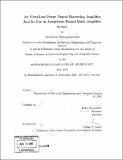Communication satellite power amplifiers: current and future SSPA and TWTA technologies
Author(s)
Aniceto, Raichelle; Cahoy, Kerri; Lohmeyer, Whitney
Downloadcommunication satellite power amplifiers.pdf (1.154Mb)
Metadata
Show full item recordAbstract
This study captures the state of current satellite transponder technology, specifically, solid-state power amplifiers (SSPAs) and traveling wave tube amplifiers (TWTAs), and describes expected future advances, including GaN SSPAs. The findings of five previous SSPA and TWTA studies, including the 1991 European Space and Technology Center study, the 1993 National Aeronautics and Space Administration study, and three Boeing studies conducted in 2005, 2008, and 2013, are tabulated and summarized. The results of these studies are then compared with new analyses of two validated sources of amplifier data: a commercially licensed database, Seradata's Spacetrak, and a publicly available database, Gunter's Space Page. The new analyses consider a total of 18,902 amplifiers (6428 TWTAs, 2158 SSPAs, and 10,316 unspecified amplifiers) onboard 565 communications satellites launched from 1982 to 2016. This new study contains the largest number of satellites and amplifiers to date and compares output power, redundancy, and bandwidth capabilities. We find an increase in output power from the 1993 study of >200% for Ku-band TWTAs and C-band SSPAs, and >1000% increase for C-band TWTAs. The ratio of operational to redundant amplifiers is 10 times higher for TWTAs than SSPAs, and the majority of amplifiers over the past 30 years operate with bandwidth less than 100 MHz. A second analysis is conducted using failure records and telemetry of 16 geostationary satellites equipped with 659 amplifiers: 535 SSPAs and 124 TWTAs. We find that <2% of TWTAs and 5% of SSPAs experience anomalies. Overall, this research was performed to update and clarify how the power and bandwidth needs and redundancy trends of the SatCom community have evolved over the past 30 years.
Date issued
2016-04Department
Space Telecommunications Astronomy and Radiation (STAR) Lab; Massachusetts Institute of Technology. Department of Aeronautics and AstronauticsPublisher
Wiley
Citation
Lohmeyer, W., Aniceto, R., & Cahoy, K. (2016). Communication satellite power amplifiers: current and future SSPA and TWTA technologies. International Journal Of Satellite Communications And Networking, 34(2), 95-113. doi:10.1002/sat.1098
ISSN
1542-0973
Keywords
communication satellite power amplifiers, satellite transponder technology, solid-state power amplifiers, SSPA, traveling wave tube amplifiers, TWTA, amplifier data
Collections
Related items
Showing items related by title, author, creator and subject.
-
An ultra-low-power neural recording amplifier and its use in adaptively-biased multi-amplifier arrays
Wattanapanitch, Woradorn (Massachusetts Institute of Technology, 2007)The design of a micropower energy-efficient neural recording amplifier is presented. The amplifier appears to be the lowest power and most energy-efficient neural recording amplifier reported to date. I describe low-noise ...
